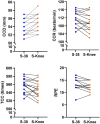Effect of Ambulance Stretcher Bed Height Adjustment on CPR Quality and Rescuer Fatigue in a Laboratory Environment
- PMID: 34220306
- PMCID: PMC8241775
- DOI: 10.7150/ijms.59037
Effect of Ambulance Stretcher Bed Height Adjustment on CPR Quality and Rescuer Fatigue in a Laboratory Environment
Abstract
Background: The quality of cardiopulmonary resuscitation (CPR) is closely related to the survival rate of a patient, and it is crucial to maintain the quality of CPR during the ambulance journey to the receiving hospital. The purpose of this study was to investigate the effects of different stretcher bed heights on operator CPR quality. Methods: In this randomized crossover trial, 16 male emergency medical technicians-paramedics (EMT-Ps) performed continuous chest compressions on a hemimorphic mannequin for 5 minutes, alternating between the current height of the stretcher bed on the ambulance (38 ± 1 cm) (S-38) and the height of the participant's midpoint of the patella (S-knee), where the stretcher bed surface is. Results: According to the analysis of the quality of CPR exercises with two different stretcher bed heights at 5 minutes of continuous chest compression, the mean chest compression depth (CCD) of the S-38 position (53.81 ± 1.91 cm) was significantly lower than that of the S-knee (55.12 ± 2.03 cm; p < 0.001). The mean chest compression rate (CCR) of the S-38 position (111.44 ± 3.44 beats/min) was significantly higher than that of the S-knee (109.63 ± 4.46 beats/min; p = 0.027). The mean of total chest compressions (TCC) of the S-38 position (557.44 ± 16.81 times) was significantly higher than that of the S-knee (548.24 ± 19.40 times; p = 0.029). The rating of perceived exertion (RPE) of the S-38 position was significantly higher than that of the S-knee (12.75 ± 1.91 %; p = 0.015). Only the chest compression rebound rate (CCRR) (S-38: 97.56 ± 4.63 % vs. S-knee: 98.31 ± 1.89 %, p = 0.401) and the chest compression fraction (CCF) (S-38: 98.44 ± 0.81 % vs. S-knee: 98.44 ± 0.96 %, p = 1.000) did not reach a significant difference. Conclusion: When a resuscitator is performing chest compressions in a standing position in an ambulance, the excessive downward leaning of the resuscitator's upper body affects CPR quality and increases fatigue. This study has verified that setting the stretcher bed of the ambulance at the knee height of the EMTs provides better CPR quality and lower fatigue.
Keywords: CPR quality; ambulance; chest compression; rescuer fatigue; stretcher bed.
© The author(s).
Conflict of interest statement
Competing Interests: The authors have declared that no competing interest exists.
Figures
Similar articles
-
Chest Compression Fraction between Mechanical Compressions on a Reducible Stretcher and Manual Compressions on a Standard Stretcher during Transport in Out-of-Hospital Cardiac Arrests: The Ambulance Stretcher Innovation of Asian Cardiopulmonary Resuscitation (ASIA-CPR) Pilot Trial.Prehosp Emerg Care. 2017 Sep-Oct;21(5):636-644. doi: 10.1080/10903127.2017.1317892. Epub 2017 May 3. Prehosp Emerg Care. 2017. PMID: 28467138 Clinical Trial.
-
The feasibility of emergency medical technicians performing intermittent high-quality cardiopulmonary resuscitation.Int J Med Sci. 2021 Apr 29;18(12):2615-2623. doi: 10.7150/ijms.59757. eCollection 2021. Int J Med Sci. 2021. PMID: 34104093 Free PMC article.
-
Quality between mechanical compression on reducible stretcher versus manual compression on standard stretcher in small elevator.Am J Emerg Med. 2016 Aug;34(8):1604-9. doi: 10.1016/j.ajem.2016.05.072. Epub 2016 May 29. Am J Emerg Med. 2016. PMID: 27318749 Clinical Trial.
-
Chest compression-only CPR or good quality 30:2 CPR.Singapore Med J. 2011 Aug;52(8):576-81. Singapore Med J. 2011. PMID: 21879215 Review.
-
Intentional interruptions during compression only CPR: A scoping review.Resusc Plus. 2024 Apr 4;18:100623. doi: 10.1016/j.resplu.2024.100623. eCollection 2024 Jun. Resusc Plus. 2024. PMID: 38590448 Free PMC article.
Cited by
-
Detection and Evaluation for High-Quality Cardiopulmonary Resuscitation Based on a Three-Dimensional Motion Capture System: A Feasibility Study.Sensors (Basel). 2024 Mar 27;24(7):2154. doi: 10.3390/s24072154. Sensors (Basel). 2024. PMID: 38610365 Free PMC article.
-
Influence of rescuer position and arm angle on chest compression quality: An international multicentric randomized crossover simulation trial.Resusc Plus. 2024 Oct 29;20:100815. doi: 10.1016/j.resplu.2024.100815. eCollection 2024 Dec. Resusc Plus. 2024. PMID: 39526069 Free PMC article.
-
Impact of rescuer position, arm angle, and anthropometric variables on muscle fatigue during cardiopulmonary resuscitation: an international multicentric randomized crossover simulation study.Resusc Plus. 2025 May 3;24:100971. doi: 10.1016/j.resplu.2025.100971. eCollection 2025 Jul. Resusc Plus. 2025. PMID: 40486104 Free PMC article.
-
Effect of the Brief Instructional Video Intervention on the Quality of Cardiopulmonary Resuscitation.Int J Med Sci. 2023 Jan 1;20(1):70-78. doi: 10.7150/ijms.79433. eCollection 2023. Int J Med Sci. 2023. PMID: 36619233 Free PMC article.
References
-
- National Fire Agency, MOI, TaiwanWhite paper on fire service, 2019. (Accessed 6 November. 2020. at https://ebook.nfa.gov.tw/whitepaper/108/#p=1)
-
- Kleinman ME, Brennan EE, Goldberger ZD. et al. Part 5: adult basic life support and cardiopulmonary resuscitation quality: 2015 American Heart Association Guidelines Update for Cardiopulmonary Resuscitation and Emergency Cardiovascular Care. Circulation. 2015;132:S414–S435. - PubMed
-
- Bekgöz B, Şan İ, Ergin M. Quality Comparison of the Manual Chest Compression and the Mechanical Chest Compression During Difficult Transport Conditions. J Emerg Med. 2020;58:432–438. - PubMed
-
- Merchant RM, Topjian AA, Panchal AR. et al. Part 1: Executive Summary: 2020 American Heart Association Guidelines for Cardiopulmonary Resuscitation and Emergency Cardiovascular Care. Circulation. 2020;142:S337–S357. - PubMed
-
- McDonald CH, Heggie J, Jones CM. et al. Rescuer fatigue under the 2010 ERC guidelines, and its effect on cardiopulmonary resuscitation (CPR) performance. Emerg Med J. 2012;30:623–627. - PubMed
Publication types
MeSH terms
LinkOut - more resources
Full Text Sources
Medical



